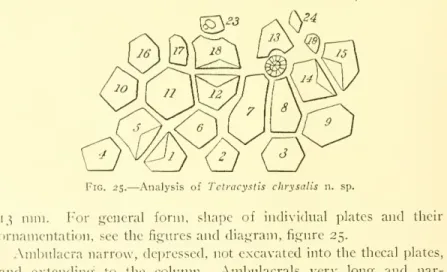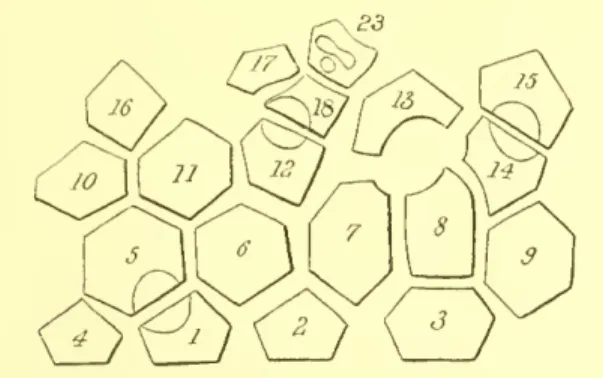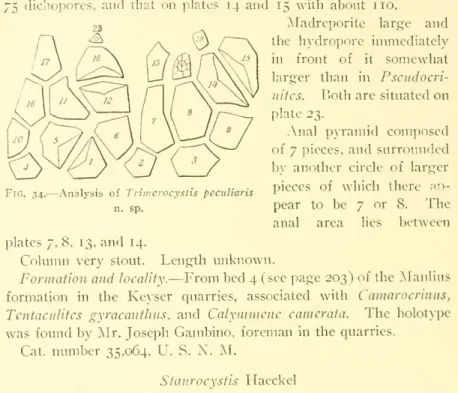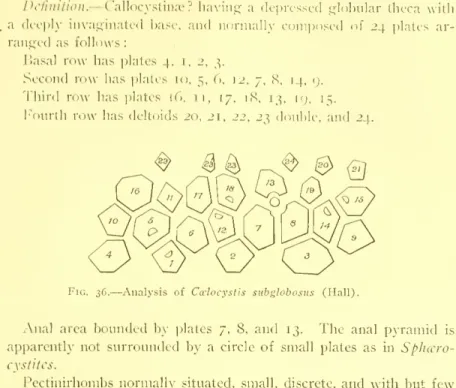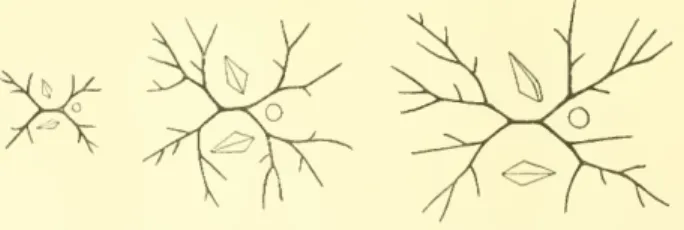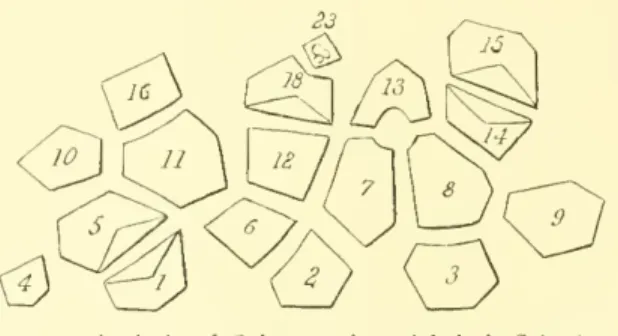Base sloped, with the convex side longer, and a deep concavity for column insertion. Formation and location. - Found in the upper half of the Oriskany Sandstone, associated with the Spiriferarenosus fauna.
212 SMITHSONIAN MISCELLANEOUS COLLECTIONS [VOL. 47
From the point of view of correct definition, Lepocrinites originates from Hall's redescription of the genus in 1859, where he changes the orthography to Lepocrinus or Lepadocrinus because "the name Lepocrinites was derived from its resemblance to Lepas or Barnacle, Antifa, and is. Bather rightly goes back to the first clear use of the name, when which he gave the genus to Mather on account of his fairly accurate number, but accepts Hall's emended orthography, Lepado-.
2 14 SMITHSONIAN MISCELLANEOUS COLLECTIONS [VOL. 47
In the cystid layer, however, occur the leech-shaped fused parts of the column, so characteristic of Lepo-. Lepocrinite differs in having plates only 3. limit the anal area instead of 4 as in the new genus.
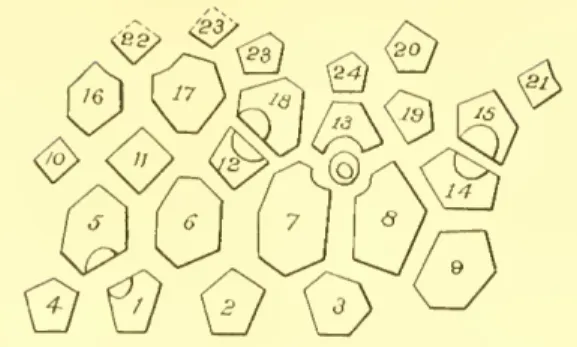
2 20 SMITHSONIAN MISCELLANEOUS COLLECTIONS [VOL. 47
However, as has been and still is the custom of the Smithsonian Institution to refer all manufacturers. Since 1850, most of the species have been described, especially Hall, but what remains of the new species will be revived in the near future.
222 SMITHSONIAN MISCELLANEOUS COLLECTIONS [VOL. 4/
Anal area small hut conspicuous and protruding, only consisting of the pyramid of 6 pieces. However, it differs from Jaekelocystis in having plate 19, and therefore has 6 plates in the fourth circle of the theca.
224 SMITHSONIAN MISCELLANEOUS COLLECTIONS [VOL. 47 pectinirhombs are large with the halves adjoining, and the brachioles
Anal pyramid small, nol strong) elevated, composed of 6 pieces, but made rather prominent by the projection of the bordering edges of thecal plates 7, 8, 13 and 14. Anal region less prominent than in the other species of this genus, and bounded by plates 7, 8 , 13 and only a very small part of 14.
2 26 SMITHSONIAN MISCELLANEOUS COLLECTIONS [VOL. 47
Below this upper section, the pillar retains an almost equal diameter, and the pieces may be interspersed with larger ones, all having a rounded periphery. The number and arrangement of the thecal plates is the same in all species (except P. abnormalis).
23O SMITHSONIAN MISCELLANEOUS COLLECTIONS [VOL. 47
That the two forms are really closely related is shown by the arrangement of the anal. Comparisons.— This species is easily distinguished from all other pseudocrinites by the strongly stellate formation of the plates.
234 SMITHSONIAN MISCELLANEOUS COLLECTIONS [VOL. 47 Basal pectinirhomb in the specimen of average size above men-
In specimen number i, the 2 ambulacra are rapidly narrowed and extend along the circumference of the run for one third. All are from the Manli cystid beds in quarries near Keyser, West Virginia.
23^ SMITHSONIAN MISCELLANEOUS COLLECTIONS [VOL. 47 difference is that whereas plates 10 and 16 in Pseudocrinites are
For these reasons, the author changed the nomenclature of the rays in Pseudocrinites from R II and R V to R I and R IV. Although Trimerocystis is based on a single specimen, with clear relationships to Pseudocrinites elarki, it cannot be considered a specimen of that species because the two forms do not occur in the same bed. Trimerocystis peculiaris was not found in the cyst horizon at Keyser, but above it (probably less than 10 feet), in association with Caiuarocriiius, and is the only known cyst in this zone.
Under these circumstances, and in order that the general definition of the Pseudocrinites may stand, the writer has deemed it advisable to erect a new genus for this 3-rayed type. Ambulacre prominent, rounded, extending along three sides, curving around the excavated base of the cap and touching the column.
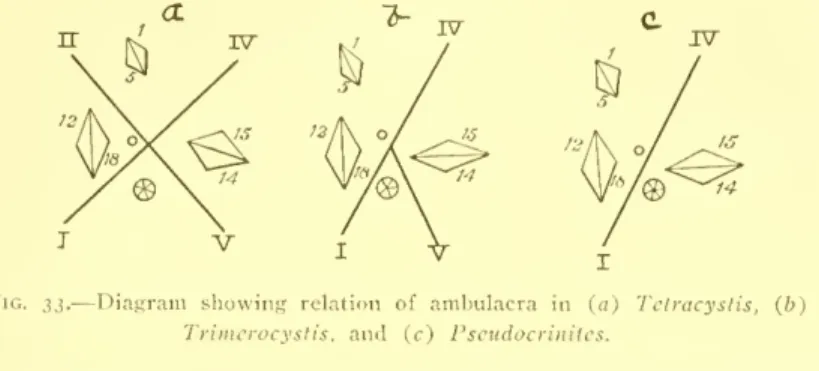
240 SMITHSONIAN MISCELLANEOUS COLLECTIONS [VOL. 47 Basal pectinirhomb and that on plates 12 and 18, each with about
His comments are as follows: 'The theca is eight-sided in cross-section because of the four ambulacra; the free sides are slightly curved. The anus and the pectinirhombs, constructed and situated as in Psendocrinites, are equally distributed on the thecal sides between the ambulacra, so that the anus lies between R IV and R V, the basal rhomb between R 1 and R II, and the upper rhombs. One in. From the description and figures it is clear that Staurocystis is very closely related to the Pseudocrinites, as the plate structure is exactly the same in both; this also applies to the structural details of the ambulacra.
Pseudocrinites and Staurocystis further agree in having the plates of the setae alike, but in Trimerocystis they are arranged differently. Jaekel's diagram of this region, however, shows that plate 19 of Forbesis is a part of plate 13, and that the arrangement of the thecal plates around the anal region is as stated above, viz.
242 SMITHSONIAN MISCELLANEOUS COLLECTIONS [VOL. 47 In the Treatise on Zoology, Bather makes Staurocystis a synonym
In the writer's opinion, Haeckel's general distinction does not even warrant a variety. In some mature individuals, the 5 primary ambulacra remain simple: in others they all bifurcate once, making 10 ambulacra near the base of the tassel; in still others, all branch except the ray on the left. There is also no regularity in the period of branching, but as a rule it is done before reaching half the size of the stem.
The lower half of the column consists of tall and slender, longitudinally striped segments. In a larger but less typical specimen 4, the ambulacra is divided, but in this case the simple one is to the left of the anus.

246 SMITHSONIAN MISCELLANEOUS COLLECTIONS [VOL. 47 the elongated pores being continuous across the suture between the
GLOBULARIS OVALIS n. var
In addition to the smaller size and rounded ovoid outline of the theca, the variety is further distinguished by the fact that the four ambulacra are always less forked.
2 54 SMITHSONIAN MISCELLANEOUS COLLECTIONS [VOL. 47 This imperfectly understood echinoderm has been variously re-
34; The basal part occupies a subcircular area, which is placed in a central position with respect to the arrangement of the lobes of the body, and is surrounded by a raised projection or extension of the walls, [a structure of which this area consists spreading , radiciform, split rays, connected by irregular polygonal plates. basal ra\'s are composed of joints similar to those of an ordinary crinoidal column, and vary in number from five to twelve or more, and are arranged symmetrically with respect to two axes at right angles; they divide on the third or fourth segment from their origin and enclose ambulacra. openings that penetrate into the internal cavities. The outer wall of the dome consists of two separate layers, the inward folding and extension of the inner ones forming the partitions that separate the rooms. The inner canal is five-lobed and is divided and bounded by the basal rays and their branches; not emptying into an internal cavity of the body, as far as observed."
Some characters would point out that it is a curiously modified and enlarged pinnacle or dome; that the viscera is a small internal chamber immediately above the column attachment; and that the lobes are an abnormal development of the interbrachial or interradial spaces. Ancyrocrinus from the groups Boven Helderberg and Hamilton, in . where there is a bulbous growth at one end of the column. believed to act as a float or anchor for the body and arms. In this respect it can be regarded as a trunk with large chambers, with an attached column, at the distal end of which was a calyx, with hitherto unknown characters of time.
256 SMITHSONIAN MISCELLANEOUS COLLECTIONS [VOL. 47
He regarded them as the type of a new and distinct class of Echinoderma, differing in their composition from all others 'by the want of all regularity.' These remarkable, irregularly rounded, bladder-like bodies, attaining" a diameter of several (up to [8) centimeters, were shown by Barrande in [3 |>latrs.not yet published, of the work of it (provisionally designated as tab. entirely the structure of an ordinary crinoid column; the single segments show on the articulating surfaces a central opening (stone channel) and a regular star figure with five rays.
This characteristic structure is entirely confined to the class Crinoidea, and occurs in no other Echinoderma; it is absent in the true Cystoidea and also in the Amphoridea. This fact indicates that in the Crinoidea alone the 'chamber organ', or the five-chambered tube, extends from the base of the cup through the hollow segmented column.
258 SMITHSONIAN MISCELLANEOUS COLLECTIONS [VOL. 47
Kuchclbad [the writer also saw one at this locality, to which reference will be made later] on the exposed surfaces of the strata. Of Scyphocrinus we know only a few with attached columns; most of the columns occur in isolation and these. may belong to other genera. There is absolutely no evidence of other crinoid material in most of the deposit that contains Camarocrinus."
It is also noteworthy that this plate was collected at one of the two localities in which a few fragments of other Crinoidea were found in association with Camarocrinus. Foerste found many specimens of Camarocrinus saffordi extending through the lower 50 feet of the Linden Formation.
262 SMITHSONIAN MISCELLANEOUS COLLECTIONS [VOL. 47
Imme-. Within the base of the sphere is a large, more or less pentagonal medio-basal chamber, around which are usually arranged five or six chambers, and more rarely n differently shaped chambers. The walls of the camane originate in divisions of the roots under the stem. Each lobe has a large opening in the base of the theca, immediately within the lateral basal extension or basal border of the outer wall.
Communicating pores, irregularly distributed, exist between the outer and inner wall plates, except for those of the base below the mediobasal chamber. In many of the Indian Territory specimens, the lower part of the bulb extends into a high collar with 10 to 15 mm thick walls.
264 SMITHSONIAN MISCELLANEOUS COLLECTIONS [VOL. 47
The length of the stem is unknown, because the bulbs never retain a length longer than 15 mm. The round end of the bulb is full of pores, and what purpose could these have served if they were hidden in the mud? Formation and place. Not common in the tentaculite limestone of the upper Manlius near Schoharie, New York.
View of the holotype, with the anal opening to the left and pectinirhomb of plates 14-15 to the right. A large specimen, viewed from the anal side; most of the sculpture consists of the ambulacral branches. The whole stem, ending in the roots on one side and preserving some of the thecal plates on the other, seen from the inside.
Part of an ambulacrum; cross marks in the ambulacral groove indicate the position of the ambulacral, but not the plates themselves.
